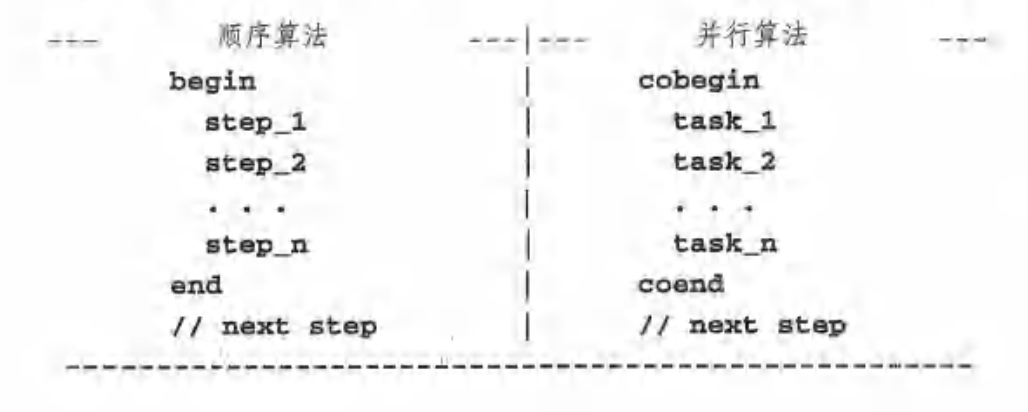第四章 并发编程
并行计算
要求解某个问题,先要设计一种算法,描述如何一步步地解决问题,然后用计算机程序以串行指令流的形式实现该算法。在只有一个 CPU的情况下,每次只能按顺序执行某算法的一个指令和步骤。但是,基于分治原则(如二又树查找和快速排序等)的算法经常表现出高度的并行性,可通过使用并行或并发执行来提高计算速度。并行计算是一种计算方案,它尝试使用多个执行并行算法的处理器更快速地解决问题。
-
顺序算法与并行算法

begin-end代码块中的顺序算法可能包含多个步骤。 -
并行性与并发性
- 在理想情况下,并行算法中的所有任务都应该同时实时执行。
- 真正的并行执行只能在有多个处理组件的系统中实现,比如多处理器或多核系统。
- 在单CPU系统中,一次只能执行一个任务。在这种情况下,不同的任务只能并发执行,即在逻辑上并行执行。
线程
-
线程的原理
- 线程是某进程同一地址空间上的独立执行单元。创建某个进程就是在一个唯一地址空间创建一个主线程。当某进程开始时,就会执行该进程的主线程。
-
线程的优点
-
线程创建和切换速度更快
-
线程的响应速度更快
-
线程更适合并行运算
-
-
线程的缺点
-
由于地址空间共享,线程需要来自用户的明确同步。
-
许多库函数可能对线程不安全。通常,任何使用全局变量或依赖于静态内存内容的函数,线程都不安全。
-
在单CPU系统上,使用线程解决问题实际上要比使用顺序程序慢。
-
线程操作
- 线程的执行轨迹与进程类似。线程可在内核模式或用户模式下执行。在用户模式下,线程在进程的相同地址空间中执行,但每个线程都有自己的执行堆栈。
线程管理函数
-
创建线程
-
使用pthread_create()
int pthread_create(pthread_t *pthread_id,pthread_attr_t *attr,void *(*func)(void*),void *arg) -
attr 参数的使用步骤。
(1)定义一个pthread属性变量pthread attr tattr。
(2)用pthread attrinit (&attr)初始化属性变量。
(3)设置属性变量并在pthread create0)调用中使用。
(4)必要时,通过pthread attr destroy (&attr)释放attr 资源。
-
-
线程ID
int pthread_equal(pthread_t t1,pthread_t t2);如果是不同的线程,返回0,否则返回非0
-
线程终止
int pthread_exit(void *status);进行显式终止,其中状态是线程的退出状态。
-
线程连接
int pthread_join(pthread_t thread,void **status_ptr)终止线程的退出状态以status_ptr返回。
线程示例程序
-
用线程计算矩阵的和
#include <stdio.h> #include <stdlib.h> #include <pthread.h> #define N 4 int A[N][N], sum[N]; void *func(void *arg) { int j, row; pthread_t tid = pthread_self(); row = (int)arg; printf("Thread %d [%lu] computes sum of row %d\n", row, tid, row); for (j=0; j<N; j++) { sum[row] += A[row][j]; } printf("Thread %d [%lu] done sum[%d] = %d\n",row, tid, row, sum[row]); pthread_exit((void*)0); } int main (int argc, char *argv[]) { pthread_t thread[N]; int i, j, r, total = 0; void *status; printf("Main: initialize A matrix\n"); for (i=0; i<N; i++) { sum[i] = 0; for (j=0; j<N; j++) { A[i][j] = i*N + j + 1; printf("%4d" ,A[i][j]); } printf("\n"); } printf("Main: create %d threads\n", N); for(i=0; i<N; i++) { pthread_create(&thread[i], NULL, func, (void *)i); } printf("Main: try to join with threads\n"); for(i=0; i<N; i++) { pthread_join(thread[i], &status); printf("Main: joined with %d [%lu]: status=%d\n",i, thread[i], (int)status); } printf("Main: compute and print total sum:"); for (i=0; i<N; i++) { total += sum[i]; } printf("tatal = %d\n", total); pthread_exit(NULL); } -
用线程快速排序
#include <stdio.h> #include <stdlib.h> #include <pthread.h> #define N 10 typedef struct{ int upperbound; int lowerbound; }PARM; int A[N]={5,1,6,4,7,2,9,8,0,3}; int print() { int i; printf("[ "); for (i=0; i<N; i++) { printf("%d ", A[i]); } printf("]\n"); } void *qsort_1(void *aptr) { PARM *ap, aleft, aright; int pivot, pivotIndex, left, right, temp; int upperbound, lowerbound; pthread_t me, leftThread, rightThread; me = pthread_self(); ap = (PARM *)aptr; upperbound = ap->upperbound; lowerbound = ap->lowerbound; pivot = A[upperbound]; left = lowerbound - 1; right = upperbound; if (lowerbound >= upperbound) pthread_exit(NULL); while (left < right) { do { left++;} while (A[left] < pivot); do { right--;}while (A[right] > pivot); if (left < right ) { temp = A[left]; A[left] = A[right]; A[right] = temp; } } print(); pivotIndex = left; temp = A[pivotIndex]; A[pivotIndex] = pivot; A[upperbound] = temp; aleft.upperbound = pivotIndex - 1; aleft.lowerbound = lowerbound; aright.upperbound = upperbound; aright.lowerbound = pivotIndex + 1; printf("%lu: create left and right threads\n", me); pthread_create(&leftThread, NULL, qsort_1, (void *)&aleft); pthread_create(&rightThread, NULL, qsort_1, (void *)&aright);// wait for left and right threads pthread_join(leftThread, NULL); pthread_join(rightThread, NULL); printf("%lu: joined with left & right threads\n", me); } int main(int argc, char *argv[]) { PARM arg; int i, *array; pthread_t me, thread; me = pthread_self(); printf("main %lu: unsorted array =" ,me); print(); arg.upperbound = N-1; arg.lowerbound = 0; printf("main %lu create a thread to do QS\n", me); pthread_create(&thread, NULL, qsort_1, (void *)&arg); // wait for QS thread to finish pthread_join(thread, NULL); printf("main %lu sorted array = ", me); print(); }
线程同步
多个线程试图修改同一共享变量或数据结构时,如果修改结果取决于线程的执行顺序,则称之为竞态条件。在并发程序中,绝不能有竞态条件。否则,结果可能不一致。
-
互斥量
-
最简单的同步工具是锁,它允许执行实体仅在有锁的情况下才能继续执行。在 Pthread中,锁被称为互斥量,意思是相互排斥。
-
静态方法
-
动态方法
-
-
死锁预防
-
互斥量使用封锁协议。
-
在任何封锁协议中,误用加锁可能会产生一些问题。
-
死锁是一个状态,在这种状态下,许多执行实体相互等待,无法继续进行下去
-
-
条件变量
-
静态方法
-
动态方法
-
-
生产者-消费者问题
共享全局变量:int buf[NBUF]; int head,tail; int data; -
信号量
-
信号量是进程同步的一般机制。
-
在使用信号量之前,必须使用一个初始值和一个空等待队列进行初始化。
-
-
屏障
- 在 Pthreads中,可以采用的机制是屏障以及一系列屏障函数。
-
用并发线程解线性方程组
-
Linux中的线程
-
Linux不区分进程和线程。
-
对于Linux内核,线程只是一个与其他进程共享某些资源的进程。
-
在 Linux 中,进程和线程都是由 clone()系统调用创建的:
int clone(int (*fn)(void*),void *child_stack,int flags,void *arg)
-
苏格拉底挑战
关于线程的苏格拉底挑战

关于线程同步的苏格拉底挑战

遇到的问题
问题:线程中,线程调度是如何进行的?
解决方法:问gpt
GPT的回答:
